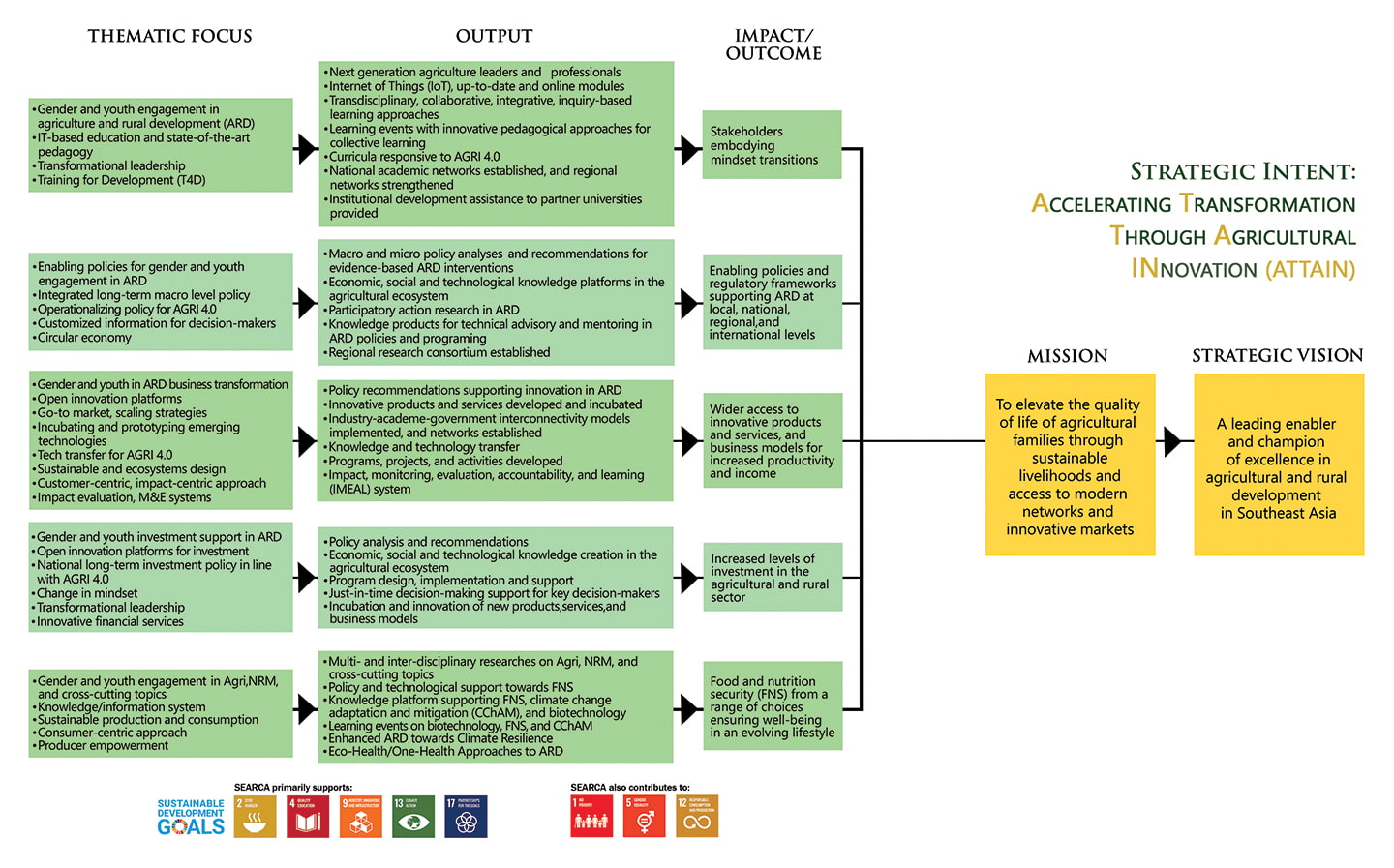What We Do
Accelerating Transformation Through Agricultural Innovation (ATTAIN)
SEARCA has embraced the rhythms of change. Its Tenth Five-Year Plan (FYP) has directed SEARCA to move away from "business-as-usual" strategy as it no longer suffices in coping with the increasing complexities, uncertainties, and nonlinearities of its constantly changing environment. The "new normal" conditions in Southeast Asia compels SEARCA and all of its key partners to initiate anew a paradigm shift towards accelerating transformation through agricultural innovation (ATTAIN) in its Eleventh FYP.
SEARCA's 11th Five-Year Plan (FY 2020/2021 – 2024/2025) Executive Summary
SEARCA's 11th Five-Year Plan (FY 2020/2021 – 2024/2025) Full Document:
Strategic Intent
SEARCA aligns with other global, regional and national organizations toward contributing to the achievement of the Sustainable Development Goals (SDGs) that address global challenges to achieve a better and more sustainable future for all. The Center commits to contribute and allocate resources toward the achievement of five SDGs that directly align with its mandate and focus, with greater emphasis on creating partnerships (SDG17). Moreover, SEARCA touches three other SDGs as it tries to achieve the five as shown below.
Mission
To elevate the quality of life of agricultural families through sustainable and resilient livelihoods and access to modern networks and innovative markets
Vision
A leading enabler and champion of excellence in agricultural and rural development in Southeast Asia
The Center will make this possible by enabling its key partners, which include National Governments, Development and Financial Organizations, Industry, Academic Institutions, Cooperatives, and Farmers' Associations, to help farmers and farming families:
-
Access new and innovative financial services
-
Adopt new, sustainable, and resilient production technologies and systems
-
Integrate with modern postharvest and logistics systems
-
Gain access to and operate in modern networks and markets
SEARCA Priority Areas
- Agri-Business Models for Increased Productivity and Income
- Sustainable Farming Systems and Natural Resource Management
- Food and Nutrition Security
- Transformational Leadership for Agricultural and Rural Development (ARD)
- Gender and Youth Engagement in ARD
- Enhanced ARD towards Climate Resilience
- EcoHealth/One Health Applications to ARD

To deliver the desired outcomes at the ground level, SEARCA's products and services will include:
Repositioned Products and Services
With a customer-centric approach, SEARCA repositions its products and services based on the needs of its stakeholder groups for enhancing their impact at the ground level (Table 1). Each group has different coverage, audience, and depth of impact on the farmers and farming families; hence, products and services will be customized.
For the Macro level stakeholders, the products and services will revolve around catering to their needs in policy formulation, implementation, and evaluation; and focusing on creating the next generation of agricultural leaders and managers.
For the Mid-level or Meso level stakeholders like the HEIs, the focus is on enabling them to align their program designs and implementation strategies with the future concept of agriculture.
Lastly, the Micro level stakeholders of the Center, composed of local government entities (municipalities/districts/townships) and business entities (particularly cooperatives) that have the greatest impact at the ground level, SEARCA will produce their next generation of agricultural leaders and enable their current leaders to be equipped with technological know-how and transformational leadership skills.
Across all levels, SEARCA provides graduate scholarships, institutional development assistance, and training; research, policy and program advisory, and knowledge platforms; and technology transfer, innovation and incubation platforms, and other services customized to the needs of stakeholders and intended beneficiaries. By systematically wielding all of these services, SEARCA will continue to provide strategic capacity building services for Southeast Asia and beyond.
Table 1. Repositioned Products and Services
Core Programs
Education and Collective Learning (ECL)
Develops agriculture leaders and professionals who embody mindset transitions through:
- Graduate Scholarship and Institutional Development
- Training for Development
Research and Thought Leadership (RTL)
Leads in these key activities:
- Research for Development
- Policy and Program Advisory
- Agriculture, Forestry, and Natural Resources (AFNR) Knowledge Platform
Emerging Innovation for Growth (EIG)
Provides farmers and farming families wider access to innovative products and services as well as business models for increased productivity and income through:
- Open Innovation and Agri-Incubation
- Knowledge and Technology Transfer
- Project Development, Monitoring, and Evaluation
-
Applied Knowledge Resources
-
Finance Cluster units
-
Management Information Systems
-
Human Resources
-
General Services
-
Facilities Management
-
Partnerships
-
Risk Management and Quality Assurance















